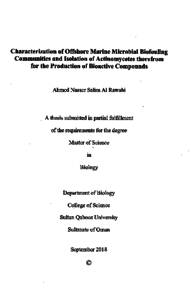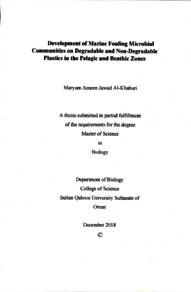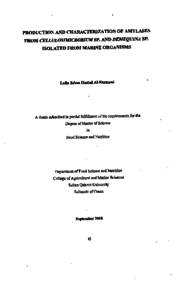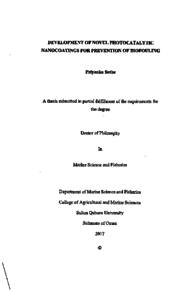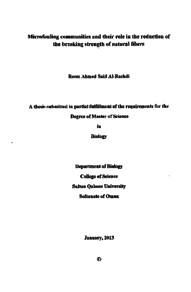Document
Characterization of Offshore Marine Microbial Biofouling Communities and Isolation of Actinomycetes therefrom for Production of Bioactive Compounds
Publisher
Sultan Qaboos University
Gregorian
2018
Language
English
English abstract
Marine biofouling communities are composed of diverse species of micro- and macro- fouling organisms. Actinomycetes comprised about 10% of the marine bacterial fouling community. Species belonging to the genus Streptomyces are well-known producers of bioactive natural products with high potential for biotechnology. In this project, the bacterial biofouling communities developed on acrylic panels deployed at different depths (3, 6 and 15 m) and at different distances from the coastline (0.5 and 1.5 km) were characterized using next generation MiSeq sequencing of 16S rRNA genes. These biofilms were used for the isolation of microorganisms, targeting specifically those belonging to Actinomycetes. The obtained strains were identified by 16S rRNA sequencing and then screened for the production of antibacterial, antifungal, antioxidants, and enzyme inhibitory compounds. Pure compounds were isolated from the strain that showed the highest bioactivity and the chemical structure of these compounds was elucidated using nuclear magnetic resonance (NMR) techniques, highresolution electron spray ionization mass spectrometry (HR-ESI-MS) and comparison with the literature data. MiSeq sequencing data revealed a clear shift in the bacterial fouling community structure, depending on both depth and distance from the coastline. The total biomass, bacterial counts and chlorophyll a of the biofilms decreased with increasing depth at both locations. Five Streptomyces strains were isolated from these biofouling communities and were molecularly identified as Streptomyces eurythermus sp.76, Streptomyces sampsonii sp.80, Streptomyces nodosus sp.81, Streptomyces andamanensis sp.83 and Streptomyces tendae sp. 89. These strains were able to produce the extracellular enzymes cellulase, phosphatase and glucosidase and their chemical extracts showed variable antibacterial, antifungal, antioxidant and enzymes inhibition activities. In our continued interest in isolation of secondary • metabolites from natural sources, three pure compounds 1-3 were isolated from the marine
strain Streptomyces nodosus. Compounds (1) 2, 4-dimethyl-docasonoic acid and (2) cyclo (Lleu-L-pro) were isolated from the marine Streptomyces nodosus strain for the first time, while compound (3) cyclo (L-leu-(N-ethenthiol)-L-pro) was isolated as new natural product. The local marine environment could provide a valuable platform for the discovery of new biologically active secondary metabolites and the search for more novel and useful compounds should not stop.
Member of
Resource URL
Arabic abstract
تتكون التجمعات البحرية من انواع مختلفة من الكائنات الحية الدقيقة والجزئية. تشكل Actinomycetes حوالي ۱۰% من مجتمع الكائنات الحية الدقيقة البحرية، حيث تتميز نوع Streptomyces منها بقدرتها العالية في انتاج المنتجات الطبيعية ذات النشاط الحيوي والامكانات العالية في تطبيقات التقنية الحيوية في هذا المشروع، تم دراسة التجمعات البكتيرية البحرية بعد جمعها من على الأسطح الصلبة التي قمنا بوضعها في وسط البحر على أعماق مختلفة ( 3، 6، و15 متر) وعلى مسافات مختلفة عن الساحل (۰٫۰ و ۱٫۵ كم) حيث تم توصيف تركيبتها باستخدام تقنية تسلسل الجيل التالي MiSeq لجينات 16S rRNA. تم استخدام هذه التجمعات الحيوية لعزل مجموعة من الكائنات الدقيقة والتي استهدفت على وجه التحديد تلك التي تنتمي إلى Actinomycetes. ولقد تم التعرف على السلالات المعزولة من خلال تسلسل الحمض النووي 16S rRNA بالإضافة إلى فحص قدرتها في إنتاج مضادات البكتيريا، مضادات الفطريات، مضادات الأكسدة والمركبات المثبطة لعمل الأنزيمات. كما تم عزل المركبات النقية من واحد من ضمن السلالات التي أظهرت نشاط حيوي عالي، وتم توضيح التركيب الكيميائي لهذه المركبات باستخدام تقنيات الرنين المغناطيسي النووي (NMR)، مطياف الكتلة التأين بالرش الكهربائي عالي الدقة ( HR- ESI - MS ) ومقارنتها بالأبحاث المحكمة المنشورة سابقا. ولقد كشفت بيانات التسلسل الجيني عن تغيرات واضحة في بنية المجتمع البكتيري وتوزيعها بناء على عاملي العمق والمسافة من خط الساحل. تم رصد انخفاض اجمالي الكتلة الحيوية، الأعداد البكتيرية و تركيز الكلوروفيل ا من التجمعات البكتيرية المتكونة في الأسطح مع زيادة عمق البحر في كلا الموقعين. أما فيما يخص السلالات المعزولة فلقد تم عزل خمسة سلالات من هذه التجمعات البكتيرية البحرية تنتمي إلى نوع Streptomyces وتم تحديد هويتها جزيئيا حسب التالي Streptomyces eurythermus sp.76, Streptomyces sampsonii sp.80, Streptomyces nodosus sp.81, 89 .Streptomyces andamanensis sp . 83 and Streptomyces tendae sp وكشفت نتائج الفحص عن امكانية هذه السلالات في إنتاج أنزيمات phosphatase scellulase و glucosidase وكما أظهرت خلاصاتها الكيميائية أنشطة حيوية كالمضادات البكتيرية والفطريات، مضادات الأكسدة وتثبيط الأنزيمات. فيما يتعلق باهتمامنا المتواصل في عزل المركبات من المنتجات الثانوية من المصادر الطبيعية، تم عزل ثلاثة مركبات نقية من السلالة البحرية Streptomyces nodosus. تم عزل المركبات (۱) ۲، 4- dimethyl - docasonoic acid و (۲) ( cyclo ( L - leu - L - pro من سلالة Streptomyces nodosus البحرية لأول مرة ، في حين أن المركب (۳)N - ethenthiol ) - L - pro ) - cyclo ( L - leu تم عزله كمنتج طبيعي جديد يسجل لأول مرة.
في الخلاصة يمكن أن توفر البيئة البحرية المحلية مصادر بكتيرية طبيعية لإكتشاف مركبات ثانوية جديدة ذات أنشطة أحيائية عالية، فيجب أن لا يتوقف البحث عن المزيد من المركبات الجديدة والمفيدة.
في الخلاصة يمكن أن توفر البيئة البحرية المحلية مصادر بكتيرية طبيعية لإكتشاف مركبات ثانوية جديدة ذات أنشطة أحيائية عالية، فيجب أن لا يتوقف البحث عن المزيد من المركبات الجديدة والمفيدة.
Category
Theses and Dissertations

